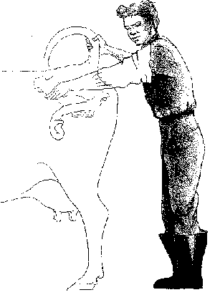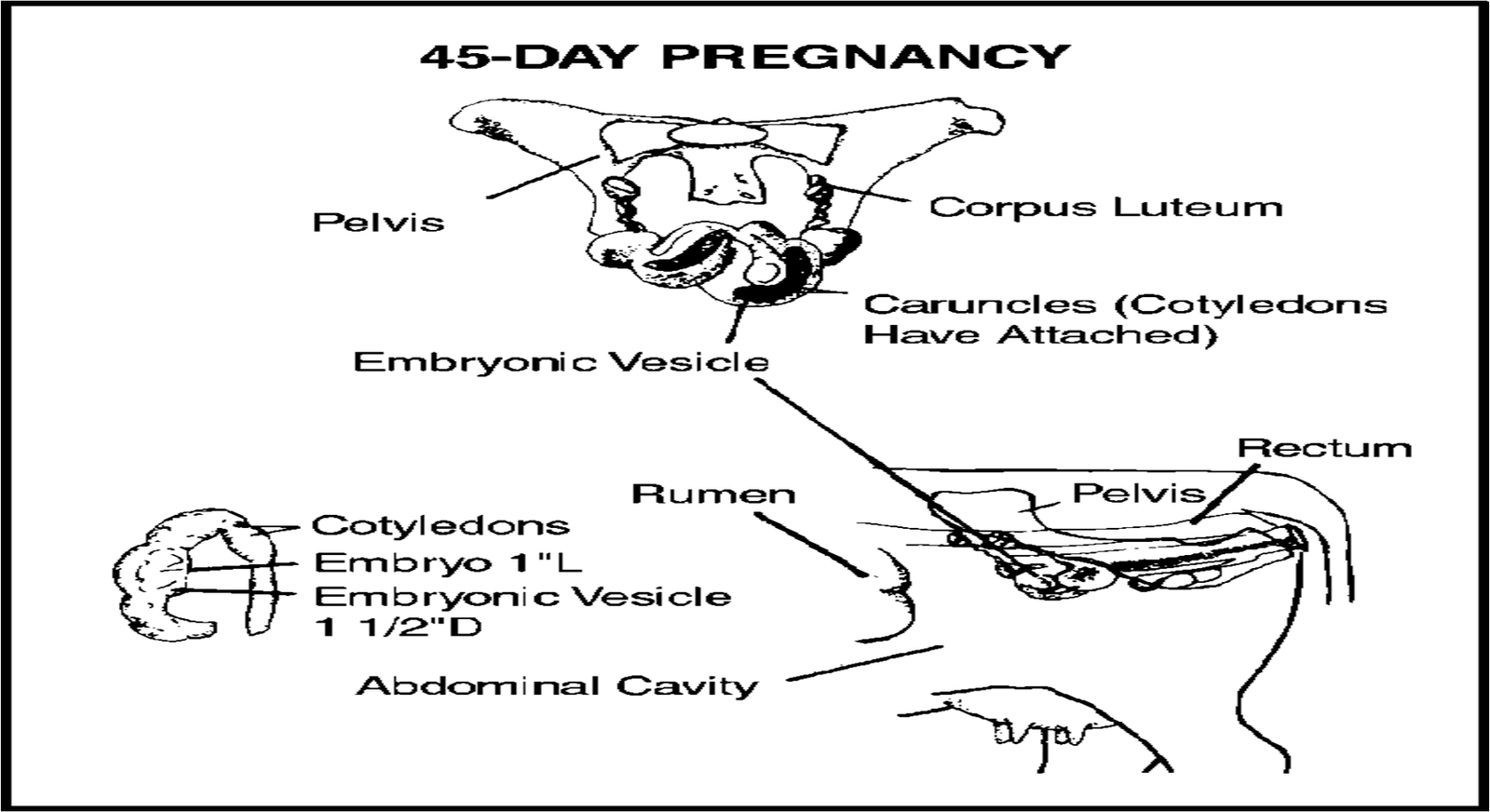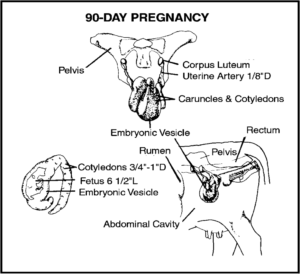BREEDING
Cattle and Buffalo
Puberty
- The stage of life in which reproductive system of the animal becomes functional
- The stage at which attainment of full reproductive capacity is denoted by another term namely sexual maturity.
- In female, puberty is indicated by occurrence of first oestrus.
- In male, puberty is denoted by the appearance of sperms in the semen.
Signs of estrus
- Behavioral changes at the beginning include anxiety, restlessness, activities like smelling and sniffing other animals, intermittent bellowing, seeking vicinity of males.
- Frequent urination in small volumes, arching of the back, rising and tilting of the head, intermittent flow of thin vaginal mucus
- Slight edema of vulvular lips and some degree of homosexual behavior such as mounting others.
- With advancement of oestrus ‘standing heat’ is observed during which the animal stand still to be mounted by other cows or bulls.
- This extends for 14-16 hrs showing bellowing, nervousness, anorexia, reduction in milk yield moist red vulva, riding other cows, dilated pupil of the eye.
- Besides this it will be the first cow to rise in the morning.
- There will be thick and clear mucus discharge flowing out or hanging at the vulva.
Even after the period of standing heat is over, there will be mucus discharge for about eight to ten hours.
HEAT SIGNS
- Mounting and accepting the male is the most important and conformational sign of heat
- Standing heat is the primary sign for detecting estrus.
- Engorgement of teat temporarily is the common sign in most of the buffaloes which is due to holding of milk following increased estrogen level in blood.
- The colour, consistency and fern pattern of mucus help in determination of correct oestrus.
The secondary signs generally appears as early as 48 hrs before the primary sign of standing heat and are as follows
- Mounting on other female animals
- Frequent micturition
- Laying of head over the back of other animals
- Nervousness and restlessness
- Bawling
- Spooking
- Standing when others are lying down
- Sometimes, the animal won’t take the feed
- Not letting the calf to suckle the milk
- Reddened and swollen vulva
- Mucous discharges which are ropy and hanging. Thin on the day of heat, becomes thick as time passes and changes the color from clear to white
- Bellowing which is sharp and for longer periods
- Having mud on rump and sides which is a sign of riding by other animals
- Rough and matted hair on tail-head (most probably the sign of late heat)
- 60-70 % of the buffalo come in heat from 6 pm to 6 am (after sunset and before sunrise) and this should be borne in mind and attendant should watch the buffaloes in the evening and early morning for expression of heat symptom
Heat detection in males
- Mounting
- Sniffing of other animals and is sniffed at by others
Heat Period
- The average period of heat is about 11 hours.
- For proper detection of heat, check the cows for atleast 3 times a day i.e., in the morning, in the afternoon and late evening by spending about 30 minutes.
Time of insemination
- Insemination should be followed in mid-estrus period and second insemination should be done at 6 hours interval.
- The cow showing heat signs in the morning, should be inseminated in the evening and if the signs are manifested in the evening, the cow should be inseminated on next day morning.
- Identifying the heat signs is important for successful conception.
Signs of approaching parturition
- The female becomes restless and may be seen raising her tail and separating herself from the herd.
- In addition, there may be mucus discharge from the vulva
- Enlarged and flabby vulva
- Restlessness and trying to kick flank region
- Decreased body temperature
- Filling of mammary glands with milk, and mild straining.
- Behavioural signs include nesting behavior and possibly stealing other newborns in the herd.
- The calf will be delivered within 12 hours after commencement of contractions
- Expulsion of placenta should be taken care of and should be removed immediately after expulsion to prevent cow eating it.
ESTRUS DETECTION AIDS
COWS:
Signs of estrus:
- Mounting on other cows
- Increased frequency of urination
- Isolation from the herd
- Mucous discharge
- Chin resting and rubbing
- Standing to be mounted
- Muddy flanks and ruffled tail head
- Vulval edema and hyperaemia
- Bellowing, restlessness and trailing
- Decreased feed intake and milk yield
Estrus Detection Aids
Estrus detection aids are needed in most herds in order to overcome the difficulty of estrus detection so that all animals in estrus are effectively identified and bred. These are only aids and should be used only in conjunction with visual observation programmes and not as a substitute for visual detection.
1. Records:
- These aids require recording off all heats (whether the animal is to be inseminated or not) including those observed in early post partum period and should be used on a daily
2. Heat expectancy charts:
- Heat expectancy charts are available in the form of calendar that are organized on a 21 day.
- This simple management aid allows heat to be recorded so that the next heat can be predicted and the cows can be watched closely around the time of approaching
3. Breeding wheel:
- These are wall mounted reproductive record systems that use color coded pins or markings to indicate the day of
- By turning a transparent plastic dial or by sliding the plastic cover on a daily basis, the future heats and reproductive events can be
4. Mount detection aids
| Detection Aid | Application | Detection Method | Management Considerations |
| Kamar ® Heat mount ® detector | Apply with separate adhesive between tail head and hip bone over the sacrum of cow | Detector remains white until triggered by weight of mounting animal, then it turns bright red | Detectors may become partially activated, making it hard to tell if heat has occurred. Detectors can become dislodged from female. |
| Estrotect™ Heat Detector | Apply with self-, adhesive between tail head and hip bone over the sacrum of cow or heifer | Detector remains silver until friction of mounting animals reveals fluorescent colour under scratched- off silver layer | Low branches, gates and other cattle; can lead to a false positive. Detectors can become dislodged from the female |
| Bovine Beacon® | Glue to tail head of cow or heifer | Contains fluorescent dye that glows in the dark when cow or heifer is mounted by another animal . | Low branches, gates, and other cattle can lead to a false positive Detectors can become dislodged from female animal |
| Tail Head Markers | Smear liberal amounts (at least 2-3”wide) of, crayon, chalk, paste, or paint marker on the tail head of cow or heifer. | When marker is rubbed off tail head (hair will be ruffled and pulled back) the cow or heifer has stood to be mounted | Low branches, gates, other cattle, humidity, and rain can lead to a false positive. May need to reapply every few days. |
| Chin-Ball Marker | Fit marker device under the chin of a teaser (gomer) bull or androgenized cow or heifer | An animal wearing device mounts and slides off the cow or heifer in heat, leaving an ink mark. on the back and hip of female. | Maintenance is necessary for continuous use (ink must be refilled). Harness straps may break or stretch. Some markings may be from chin’s resting instead of mounting. |
| HeatWatch® II | Place small, digital radio transmitter in a piece of polyester material (patch) and glue onto the tailhead of cow or heifer. | Every time there is a mount, data are sent from that transmitter to a small radio receiver(base station) in the proximity of the heat detection area. Data generated on every mount include the female mounted, date and time of the mount, and duration (in seconds) | Patches can become dislodged from females. Transmitters can fall out of patches if not adequately secured. Batteries must have proper charge Increased heat detection accuracy over other aids |
5. Vaginal Electrical Resistance:
- This method is based on the concept that the electrical resistance (ER) of vaginal fluids decreases during proestrus and through the estrus due to increase in the volume and ionic composition of the cervical and vaginal
- The estrus probe is designed to monitor these changes wherein “low” probe readings are associated with estrus.
6. Pedometers:
- Cattle are more active during estrus and thus spend more time walking and standing than resting
- Monitoring activity through the use of pedometers is a potentially valuable method for identifying cows in estrus,
- With the use of pedometers it is possible to identify some silent heat cows which fail to show obvious signs of
- Data storage capabilities in which the steps taken during a given activity period can be counted and
- Visual alert systems, which consist of a flashing light to alert the management
- Analytical capability whereby the pedometer can compare the activity that has occurred in a preset time period to the activity preceding that period. This capability allows comparison of activity within individual animals and thus increases the specificity of the
- An internal power source to operate the counting mechanism and the data storage provide a relatively long functional lifespan of the
- Recently the development of a device containing a piezoelectric sensor implanted in the perineal region of the cow can detect steps taken by a
Differential Diagnosis of Pregnancy
- Urinary bladder- may be confused with 3-4 m pregnancy. To avoid such mistake, catch hold the cervix, follow up to the horn, if enlargement is present then the animal may be pregnant and later on it can be confirmed with asymmetry, slipping of fetal membranes, fremitus and fetal bump.
- Kidney- left kidney in ruminants is loose and because of ruminal pressure it can come to pelvic cavity. It can be confused with fetal head and fetal parts. However, kidney is a lobulated organ and can be easily differentiated.
- Rumen- sometimes part of rumen is bulged in to the pelvic cavity and can be confused with pregnancy. However, rumen is doughy mass and pregnancy can be confirmed with asymmetry, slipping of fetal membranes and fremitus.
Stage | Uterus | Fetus | Placentomes | Middle ut. artery |
35-40 days | In pelvic floor, Slight fluctuation, slipping of fetal membranes, asymmetry of horns | Not palpable | – | No change |
45-50 days | In pelvic floor, asymmetry of horn, slipping of fetal membranes, pregnant horn diameter- 5-6.5 cm | Not palpable | – | No change |
60 days | Slightly over pelvic brim Appears as water filled balloon, diameter- 6.5-7.6 cm, slipping of fetal membranes, | 5 cm long, can be bumped by hand rubbing | – | Increased pulse |
90 days | Pulled well over the pelvic brim, 8-10 cm diameter | 10-15 cm long palpable fetus | Small | Pencil sized |
120 days | Not retractable with cervix pulled to the pelvic brim | 25-30 cm long, anatomical parts may be palpable | Small | Fremitus +nt |
150 days | In abdominal cavity | 35-40 cm long , may be out of reach | Distinct | Diameter of 6-1.25 cm, Fremitus- strong |
170-230d | In abdominal cavity, Dorsal wall – tight and difficult to palpate | Out of reach | Quite variable | Diameter -1.30-1.4 cm, increased fremitus |
230-280 d | – | Fetal parts and movements/reflexes distinguishable | Large sized | Increased fremitus |
Clinical Methods
- Transrectal Palpation : cattle, buffalo, swine and mare
- Radiography : sheep, goat, canine , feline
- Ultrasonography : all species
- Abdominal ballotement : cattle, buffalo, sheep , goat
- Recto abdominal method : Sheep
Trans rectal palpation in cattle
- Precautions to be taken :
- Nail trimming
- Avoid vigorous movements of the hand (esp. Mare & Buffalo)
- Avoid palpations during a peristaltic wave.
- No exam without sleeves / gloves
- Avoid kicks and remove arms if animal moves (fracture)
- Avoid using dirty soiled sleeves/ gloves
- Replace gloves after 2-5 animals/each exam.
- Avoid rectal palpation of pyrexic animals (blood vessels are more fragile and bleed easily)
- Avoid per rectal examination in animals with rectal tear or rectal fistula (complication in mare; peritonitis)
- Careless palpation of the uterine horns – rupture of the amniotic vesicle – early pregnancy loss
- One of the oldest method. Most practical, conventional, inexpensive, immediate method of pregnancy diagnosis in large animals.
- Its not very difficult, but it requires experience, practice, and a thorough knowledge of the cow’s reproductive system.







